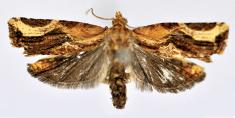Ditrifa is a genus of moths of the family Tortricidae. It contains only one species, Ditrifa trifida, which is found in Venezuela.

Clepsis rurinana is a moth of the family Tortricidae. It is found in most of Europe, with the exception of Ukraine and part of the Balkan Peninsula, east to the Near East and the eastern part of the Palearctic realm. It is also present in the Indomalayan realm.

Isodemis stenotera is a moth of the family Tortricidae. It is known from China and Indonesia (Sumatra).

Isodemis quadrata is a moth of the family Tortricidae. It is known from Tibet, China.
Neostatherotis pallidtornus is a moth of the family Tortricidae. It is found in Vietnam.
Rhopobota nova is a moth of the family Tortricidae. It is found in Vietnam.
Anopina confusa is a moth of the family Tortricidae. It is found in Guerrero, Mexico.
Anacrusis epidicta is a species of moth of the family Tortricidae. It is found in Bahia, Brazil.
Proeulia tricornuta is a species of moth of the family Tortricidae. It is found in the Maule Region of Chile.
Proeulia limaria is a species of moth of the family Tortricidae. It is found in Coquimbo Region, Chile.
Proeulia paronerata is a species of moth of the family Tortricidae. It is found in the Valparaíso Region of Chile.
Clarkeulia radicana is a species of moth of the family Tortricidae. It is found in Colombia, Ecuador and Peru.
Transtillaspis cothurnata is a species of moth of the family Tortricidae. It is found in Napo Province, Ecuador.

Ancylis geminana, the festooned roller, is a moth of the family Tortricidae. It was described by Edward Donovan in 1806. It is found in most of Europe and has also been recorded from North America. The habitat consists of fens, marshes and damp heathland.

Ancylis myrtillana is a moth of the family Tortricidae. It was described by Treitschke in 1830. It is found in most of Europe and across the Palearctic.It has also been recorded in North America. The habitat consists of moorland.

Gynnidomorpha alismana, the water plantain conch, is a moth of the family Tortricidae. It was described by Ragonot in 1883. It is found in most of Europe, except Spain, Switzerland, most of the Balkan Peninsula and Ukraine. Further east it is found across the Palearctic to China and Korea. It is found in riverine and other watery habitats.

Eana osseana, common name dotted shade, is a moth of the family Tortricidae.

Phtheochroa inopiana, the plain conch, is a species of moth of the family Tortricidae. It is found in China, Iran, Japan, Mongolia, Russia and most of Europe. It has also been recorded in North America. The habitat consists of damp areas and woodland edges.

Apoctena persecta is a species of moth of the family Tortricidae. It is found in New Zealand, where it is found only on the South Island.

Eucosma cana, the hoary bell, is a species of moth of the family Tortricidae.








